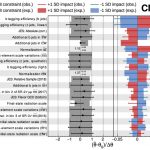Yungi Kwon, Jung-Hoon Jung and Young-Ho Eom
Chaos 33, 113104 (2023)
Abstract
Making the connection between the function and structure of networked systems is one of the fundamental issues in complex systems and network science. Urban traffic flows are related to various problems in cities and can be represented as a network of local traffic flows. To identify an empirical relation between the function and network structure of urban traffic flows, we construct a time-varying traffic flow network of a megacity, Seoul, and analyze its global efficiency with a percolation-based approach. Comparing the real-world traffic flow network with its corresponding null-model network having a randomized structure, we show that the real-world network is less efficient than its null-model network during rush hour, yet more efficient during non-rush hour. We observe that in the real-world network, links with the highest betweenness tend to have lower quality during rush hour compared to links with lower betweenness, but higher quality during non-rush hour. Since the top betweenness links tend to be the bridges that connect the network together, their congestion has a stronger impact on the network’s global efficiency. Our results suggest that the spatial structure of traffic flow networks is important to understand their function.



